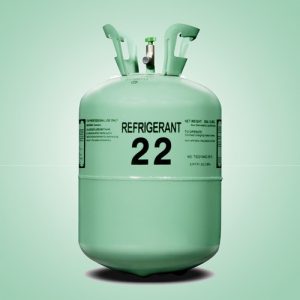R22 Replacement in Canada: The Ultimate Guide to Navigating the Phase-out
Is it against the law to operate air conditioners and refrigerators using R22 refrigerant? How soon do I have to make the change? Should I retrofit my system or replace it? Our guide has you covered.
Pop quiz: why was 2010 an important year for every building manager, homeowner and renovation company in Canada?
Answer: It’s the year HVAC companies began to phase out the installation of air conditioning units and refrigeration systems using R22 (also known as HCFC-22, or Freon) refrigerant. This was in anticipation of a nationwide import and production ban, which came into force in 2020.
If your R22 system was installed before 2010, it’s highly likely you’re going to need to replace or retrofit it within the next few years. Chances are if you’ve found your way to this page, you already know you need to do some research to learn what your responsibilities are under the new regulations. And you have some questions about what switching from R22 refrigerant will mean in practice.
This is the guide for you! We reached out to Gateway’s expert engineers and technicians to get the skinny on the most common questions we receive from customers, such as…
- What is R22 refrigerant exactly?
- What refrigerant types fall into this category (HCFC)?
- Why is R22 production being banned in Canada?
- What types of refrigerants are being used to replace R22?
- How long do I have before I need to replace my R22?
- Is recycled/reclaimed R22 still available?
- What types of equipment are affected by the change?
- What do I have to do as an equipment owner to comply with the R22 phase-out?
- Why/how do I need to retrofit my equipment to change the refrigerant?
- What type of capacity or performance changes will I notice after switching?
Use the links above to jump directly to the question you’re most curious about, or buckle up and read on from the top. We’ll do our best to keep it simple, while scattering some helpful tips along the way on how to make the switch without breaking the bank.
What is R22 refrigerant?
R22 (or HCFC-22) is the slightly shorter name for chlorodifluoromethane. This is a colorless gas most commonly used as a refrigerant or propellant. It is a type of hydrochlorofluorocarbon (HCFC) introduced in the 1950s.
It quickly became the standard for AC units until developed countries like Canada, the US, and EU member states began to phase it out in the 2010s. This phase-out was in accordance with the Montreal Protocol (more on that later).
R22 offers a variety of advantages over previously popular refrigerants, such as:
- Ammonia (highly toxic and flammable)
- Propane (flammable and explosive)
- Chlorofluorocarbons or CFCs (a major greenhouse gas, and primarily responsible for ozone layer depletion)
In addition to how it compared to its competition, until recently, most HVAC installers also favored R22 because of its stability and relative cheapness to produce.
What refrigerant types fall into this category (HCFC)?
R22 is marketed under a variety of brand names, many of which sound like supervillain science projects, such as Genetron 22 and Arcton 4. It will be most familiar to customers under the name Freon. The Freon brand belongs to chemical giant DuPont, and actually covers a number of different CFCs and HCFCs. If your system uses Freon 22, it’s R22. The other manufacturer of note is Honeywell, which produces the Solstice and Genetron brands.

The many names of R22:
- Chlorodifluoromethane
- Difluoromonochloromethane
- Monochlorodifluoromethane
- HCFC-22
- R-22
- Genetron 22
- Freon 22
- Arcton 4
- Arcton 22
- UN 1018
- Difluorochloromethane
- Fluorocarbon-22
- Refrigerant 22
R22 is merely one of the first HCFCs on the chopping block. The United States Environment Protection Agency (EPA) began phasing out the production, import and use in new systems of R22 and R142B in 2010, with a complete ban, as of 2020.
Canada followed suit with its own distinct set of regulations, also setting a goal of eliminating remaining production and import of all HCFCs by 2030. Although R22 is by far the most common type of HCFC refrigerant, there are dozens of others.
If you know the R-name (ASHRAE number) of the gas used in your system, use Ctrl+F / Cmd⌘+F to browse Wikipedia’s list of refrigerants. You’ll find the type of refrigerant it falls under in the first column. If it’s an HCFC, you will eventually need to look into a replacement or retrofit.
Why is R22 production being banned in Canada?
If you’re just looking for practical information on what you’re required to do as a system owner, as opposed to why you’re required to do it, feel free to skip this section! If you stick around, though, you may learn a little about why this change has major implications for the health of the planet.
You may remember the worldwide panic that ensued when it was discovered in the 1980s that a seasonal “hole” over the Antarctic had formed in the Earth’s ozone layer. Without the shielding provided by the ozone, all life on Earth would be fricasseed by the sun’s ultraviolet radiation.
Research correlated the ozone layer’s depletion with widespread use of CFCs in heavy industry, aerosol cans, and air conditioning units.
When CFCs break down in the stratosphere, they release atomic chlorine. This causes destructive chain reactions in the surrounding molecules.
Upon realizing that their bread-and-butter products were in danger of being outlawed, manufacturers rushed to replace CFC refrigerants with HCFCs. These have a markedly lower impact on the ozone, as they tend to break down more completely before reaching the stratosphere.
(They are not, however, completely ozone-neutral. They are also a major greenhouse gas, which makes them a leading cause of man-made climate change. On top of that, R22 production also creates a byproduct called HFC-23. Atmospheric HFC-23 levels are rising to unexpected and dangerous levels, and most of these emissions aren’t accounted for.)
The Montreal Protocol, which was agreed upon in 1987, outlaws the use of CFCs under most circumstances. It’s one of the few international agreements that has been universally ratified by every country in the world. More recently, the Protocol was updated to also ban HCFCs. That’s why your search engine brought you here to learn what you should do next.
What types of refrigerant are being used to replace R22?
Just as HCFCs replaced CFCs, so too will HCFCs be replaced by hydrofluorocarbons (HFCs). These compounds lack the atmosphere-damaging chlorine found in CFCs and HCFCs. They are expected to mitigate further ozone depletion, though they also have a high global warming potential (GWP).
Some organizations are moving for them to be banned as well. A new ruling from the Environmental Protection Agency, issued in May 2021, will require the United States to reduce HFC production and import. It isn’t clear yet what the replacement systems will be. This development could affect Canada’s approach to R22 alternatives.
In the meantime, however, most (if not all) newly manufactured air conditioning units have already transitioned to the use of R410A (HFC410A). You may know under it under the Honeywell brand name Puron.
For owners of older R22 units who prefer to retrofit rather than replace their system, R438A is an HFC replacement that behaves similarly enough to R22 to use the same metering devices. R438A is marketed by DuPont as ISCEON MO99, though there are other brands out there.
How long do I have before I need to replace my R22?
There’s an old Chris Rock bit about how instead of outlawing guns, we should just make bullets extremely expensive. There’s a bit of that logic at work in terms of the Canadian government’s R22 ban.
You see, there’s no ban on existing systems that use R22. But now that the refrigerant is no longer being widely manufactured and imported, it may soon become prohibitively expensive to run these units as the amount of supply dwindles.
In 2017, the Canadian government released a projected phase-out timeline, which you can see below:
R-22 phase-out timeline*
| Year | 2017 | 2018 | 2019 | 2020 |
| % Reduction from past production baseline | 75% | 85% | 90% | 95% |
* Note: This timeline was produced prior to the implementation of the new regulations. When the Canadian government updates their timeline, we’ll update our guide here as well, if there are substantial changes.
This means you’re running out of runway to make the change. It’s recommended you consult your service provider about a retrofit or replacement. Being proactive may save you on operation and maintenance costs in the long term.
Is recycled/reclaimed R22 still available?
As of 2020, newly manufactured and imported R22 refrigerant can no longer be purchased by certified technicians for servicing older air conditioners.
There are ways to recycle or reclaim R22. In fact, the practice was common as a way of cutting down on costs and environmental impact well before the last update to the Montreal Protocol. What’s changed, however, is that after 2020, now you can only buy recycled or reclaimed R22 in Canada.
It’s worth noting that recycling and reclamation are not one and the same.
Recycling is a process whereby a refrigerant’s contaminants are reduced via oil separation and filtration. It is strongly recommended by our technicians that you should only use recycled refrigerant that has been collected from your own system.
Reclamation is more complex. It involves filtering, drying, distilling, and chemically treating used refrigerant to completely strip impurities. Properly reclaimed R22 must meet the same purity standards as new or “virgin” R22.
Because not all of the R22 currently in use can or will be reclaimed, the pool of available refrigerant is shrinking. It is impossible at this time to project how this will impact the cost of R22 in the future. This is because no one actually knows how much stockpiled R22 is out there. Those companies which reclaim R22 will set their prices based on supply and demand.
There is a possibility that holdouts will find themselves competing over a scarce resource, with prices rising accordingly over the next few years. It’s also possible there will be so few R22 users left following the phaseout that the refrigerant will become cheaper.
As the equipment owner, you may also notice higher costs due to increased environmental levies on the sale and import of both new and reclaimed HFCs and HCFCs. In early 2021, Refrigerant Management Canada (RMC) raised the HCFC levy by 11%, while the HFC levy saw a steeper 50% increase. These levy increases will allow RMC to continue collecting and disposing of refrigerant waste and help reduce greenhouse gas emissions.
What do I have to do as an equipment owner to comply with the R22 phase-out?
As we’ve noted, your responsibilities as an equipment owner are indirect, unless you’re managing a system that is part of a federally regulated site, such as a bank or airport. (In which case you should already be aware of your responsibilities.)
Manufacturers and service providers are the ones most directly implicated by the new regulations. Many have already adapted accordingly by switching to either R410A for new air conditioning systems and R438A for short-term drop-ins, or R449A/R448A for new general refrigeration systems and R422D for short-term drop-ins.
Although you are allowed to continue operating an R22 system, if you expand the capacity of your existing system, you become ineligible to purchase or use virgin R22. This is because, from the perspective of regulators, an expanded system is considered a new system.
You are ultimately accountable for your own bottom line, especially if you’re a manager or owner of a business or commercial enterprise. Given that the newest R22 units in Canada are now at least ten years old already, the age of your system may be a factor in your decision.
There’s no hard and fast rule for whether retrofitting an older system will prove cost-effective. It could be considerably cheaper or just as expensive as purchasing a new model. You should consult your service provider to determine what approach is best for you.
This may be a good place to note that, while R438A (a drop-in replacement option) has similar characteristics to R22, it is not the same. It should not be mixed with R22 under any circumstances, and there are significant equipment modifications that need to be made before any switch can be made. You must consult with your service provider before proceeding with any changeover.
What types of equipment are affected by the change?
The phaseout applies to virtually all equipment that uses HCFCs, with a few exceptions for certain laboratory and medical applications.
Short answer: if your equipment uses R22 or another HCFC as a refrigerant, you have some decisions to make. If you don’t know what kind of refrigerant it uses, speak to your technician or schedule an appointment to find out!
Why/how do I need to retrofit my equipment to change the refrigerant?
If you are considering retrofitting your system, a technician can help you determine whether it’s the right call for your situation.
Here are some examples of points to consider:
- If your air conditioning system has lines buried in walls and floors, it may not be possible to switch to an R410A system, leaving a retrofit as the simplest approach.
- You may be unable to afford the upfront costs of a new system.
- If your unit does not require a significant refrigerant charge to function, you may not have a pressing need to make any changes.
Typically, we do not recommend immediate refrigerant replacement on equipment that’s running normally. However, if your equipment is aging and service call frequency is on the rise, equipment replacement should be considered first.
Ultimately, whether you choose to replace, retrofit, or leave the system alone should be based on operating costs and the age of your existing equipment.
What type of capacity or performance changes will I notice after switching?
This is a question best left to your service provider! There are a number of different R22 replacements which may be recommended for your system, each of which has its own quirks and characteristics. Moreover, buying a new system complicates the question further, as newer equipment tends to be more efficient.
Conclusion
We hope this guide has provided answers to all of your burning (or cooling?) questions about what Canada’s R22 refrigerant phase-out means for you as an equipment owner or manager. The subject is necessarily complex, and we’ve only scraped the surface of the technical aspects of the question.
The best way to figure out what to do next is to have a certified HVAC technician examine your system and give you their take based on your unique needs. Gateway remains the air conditioning and refrigeration leader throughout Western Canada. We’d be more than happy to dispatch one of our service experts to assist you!
This article was originally published on May 9, 2019. It has since been updated to reflect recent developments on the subject.



